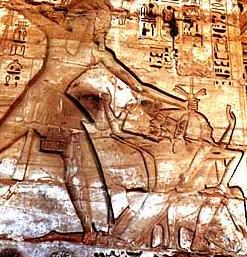Tjeker
|
|
Aquest article o secció s'està elaborant i està inacabat. L'usuari MALLUS hi està treballant i és possible que trobeu defectes de contingut o de forma. Comenteu abans els canvis majors per coordinar-los. Aquest avís és temporal: es pot treure o substituir per {{incomplet}} després d'uns dies d'inactivitat. |

The Tjekker or Tjeker were one of the Pobles de la mar. They are known mainly from the Història d'Unamon, and are thought to be the people who developed the port of Dor during the 12th century BCE from a small Bronze Age town to a large city. They are also documented earlier, at Medinet Habu, as raiders defeated by faraó Ramsès III of Egipte in years 5, 8 and 12 of his reign.
Origen
The origins of the Tjeker are uncertain. A possible identity has been suggested with the teucres, a tribe described by ancient sources as inhabiting northwest Anatolia to the south of Troia.[1][2] However, this has been dismissed as "pure speculation" by Trevor Bryce.[3]
Their name comes from Egyptian tkr or skl, which has been transcribed in other ways, such as Tjekru, Sikil, Djekker,[4] Sical,[5] etc, and has proved difficult to etymologize. As a last resort the early scholars in the field turned to modern names; specifically, Flinders Petrie related the ethnonym to Zakro, the name of a place in eastern Crete.[6] Some modern scholars accept the association.[7]
Assentament a Dor
The Tjeker may have conquered the city Dor, on the coast of Canaan near modern Haifa, and turned it into a large, well-fortified city (classified as "Dor XII", fl. c. 1150-1050), the center of a Tjeker kingdom that is confirmed archaeologically in the northern plana de Xaron. The city was violently destroyed in the mid-11th century BCE, with the conflagration firing the mud bricks red and depositing a huge layer of ash and debris. Ephraim Stern[8] connects the destruction with the contemporary expansion of the fenicis, which was checked by the filisteus further south and the israelites.
The Tjeker are one of the few Sea Peoples for whom a ruler's name is recorded — in the 11th-century papyrus account of Unamon, an Egyptian priest, the ruler of Dor is given as "Beder".
According to Edward Lipinski,[9] the Sicals (Tjekker) of Dor were seamen or mercenaries, and b3-dỉ-r was the title of the local governor, a deputy of the king of Tir.
No mention of the Tjeker is made after the story of Wenamun, during the period of archaeological and literary silence in the Near East.
Notes
- ↑ The identification of Tjeker and Greek Teukroi, Latinized to Teucri, was first made by Lauth in 1867, and was repeated by François Chabas in his Études sur l’Antiquité Historique d’après les sources égyptiennes et les monuments réputés préhistoriques of 1872, according to the Woudhuizen dissertation.
- ↑ Sandars Page 170, "The Tjeker."
- ↑ Bryce, Trevor R.The Kingdom of the Hittites. Oxford University Press, 1998 & 2005. ISBN 978-0-19-924010-4 p.339 [1]
- ↑ Grabbe, Lester L. Israel in Transition T.& T.Clark Ltd (1 Aug 2008) ISBN 978-0-567-02726-9 p97 [2]
- ↑ Lipinski, p. 96
- ↑ James Baikie mentioned it on pp. 166, 187 of his book The Sea-Kings of Crete, 2nd edition (Adam and Charles Black, London, 1913).
- ↑ Redford, p. 252.
- ↑ Page 31
- ↑ Page 96
Bibliografia
- Lipiński, Edward. On the Skirts of Canaan in the Iron Age: Historical and Topographical Researches. Peeters Publishers, 2006, p. 96–. ISBN 978-90-429-1798-9 [Consulta: 1r maig 2013].
- Redford, Donald B.. Egypt, Canaan, and Israel in Ancient Times. Princeton, New Jersey: Princeton University Press, 1992. ISBN 0-691-03606-3.
- Sandars, N.K.. The Sea Peoples: Warriors of the ancient Mediterranean, Revised Edition. London: Thames and Hudson, 1987. ISBN 0-500-27387-1.
- Stern, Ephraim (August 1990). "New Evidence from Dor for the First Appearance of the Phoenicians along the Northern Coast of Israel" Bulletin of the American Schools of Oriental Research No. 279, pp. 27–34.
- Woudhuizen, Frederik Christiaan. The Language of the Sea Peoples. Amsterdam: Najade Press, 1992. ISBN 90-73835-02-X.
- Woudhuizen, Frederik Christiaan (April 2006). The Ethnicity of the Sea Peoples. Tesi doctoral llegida a la Universitat Erasmus de Rotterdam, Faculteit der Wijsbegeerte (Facultat de Filosofia).